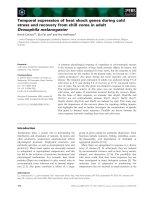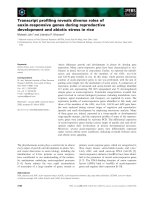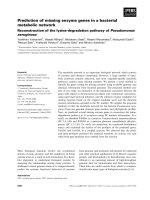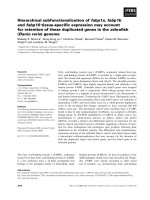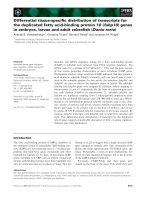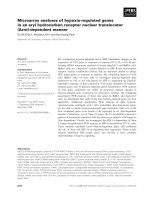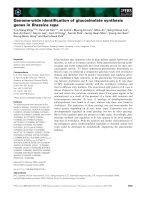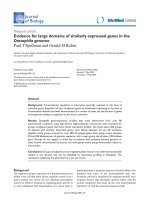Abundant RNA editing sites of chloroplast protein-coding genes in Ginkgo biloba and an evolutionary pattern analysis
Bạn đang xem bản rút gọn của tài liệu. Xem và tải ngay bản đầy đủ của tài liệu tại đây (1.49 MB, 12 trang )
He et al. BMC Plant Biology (2016) 16:257
DOI 10.1186/s12870-016-0944-8
RESEARCH ARTICLE
Open Access
Abundant RNA editing sites of chloroplast
protein-coding genes in Ginkgo biloba and
an evolutionary pattern analysis
Peng He, Sheng Huang, Guanghui Xiao, Yuzhou Zhang and Jianing Yu*
Abstract
Background: RNA editing is a posttranscriptional modification process that alters the RNA sequence so that it
deviates from the genomic DNA sequence. RNA editing mainly occurs in chloroplasts and mitochondrial genomes,
and the number of editing sites varies in terrestrial plants. Why and how RNA editing systems evolved remains a
mystery. Ginkgo biloba is one of the oldest seed plants and has an important evolutionary position. Determining
the patterns and distribution of RNA editing in the ancient plant provides insights into the evolutionary trend of
RNA editing, and helping us to further understand their biological significance.
Results: In this paper, we investigated 82 protein-coding genes in the chloroplast genome of G. biloba and
identified 255 editing sites, which is the highest number of RNA editing events reported in a gymnosperm. All of
the editing sites were C-to-U conversions, which mainly occurred in the second codon position, biased towards to
the U_A context, and caused an increase in hydrophobic amino acids. RNA editing could change the secondary
structures of 82 proteins, and create or eliminate a transmembrane region in five proteins as determined in silico.
Finally, the evolutionary tendencies of RNA editing in different gene groups were estimated using the
nonsynonymous-synonymous substitution rate selection mode.
Conclusions: The G. biloba chloroplast genome possesses the highest number of RNA editing events reported so
far in a seed plant. Most of the RNA editing sites can restore amino acid conservation, increase hydrophobicity, and
even influence protein structures. Similar purifying selections constitute the dominant evolutionary force at the
editing sites of essential genes, such as the psa, some psb and pet groups, and a positive selection occurred in the
editing sites of nonessential genes, such as most ndh and a few psb genes.
Keywords: RNA editing, Posttranscriptional modification, Ginkgo biloba, Chloroplast genome, Protein structure
Background
In the plastids and mitochondria of land plants, mature
transcripts are profoundly affected by RNA editing,
which alters the genetic information of the RNA molecules [1]. RNA editing was first documented in the coxII
gene of a trypanosome. Comparisons of the coxII transcript with homologous genes of other species showed
that the open reading frame of this gene in Trypanosoma brucei shifts due to the addition of a nucleotide in
the transcript, resulting in a new readable frame [2]. In
plants, RNA editing was found for the first time in the
coxII of Triticum aestivum [3]. Two years later, the RNA
* Correspondence:
College of life sciences, Shaanxi Normal University, Xi’an, China
editing of the rpl2 transcript was reported in maize,
which produced an initiation codon, ATG, derived from
ACG [4]. To date, more than 200 higher plant chloroplast genomes have been sequenced, but editing sites
were completely detected only in one moss (Anthoceros
formosae) [5], one fern (Adiantum capillus-veneris) [6],
two gymnosperm (Pinus thunbergii and Cycas taitungensis) [7, 8], seven eudicots (Atropa belladonna, Solanum
lycopersicum, Phalaenopsis aphrodite, Cucumis sativus,
Arabidopsis thaliana, Nicotiana tabacum and Gossypium hirsutum) [9–15], and four monocotyledons
(Oryza sativa, Saccharum officinarum, Triticum aestivum and Zea mays) [16–18].
In higher plants, RNA editing mainly occurs in the
protein-encoding genes of mitochondria and chloroplasts
© The Author(s). 2016 Open Access This article is distributed under the terms of the Creative Commons Attribution 4.0
International License ( which permits unrestricted use, distribution, and
reproduction in any medium, provided you give appropriate credit to the original author(s) and the source, provide a link to
the Creative Commons license, and indicate if changes were made. The Creative Commons Public Domain Dedication waiver
( applies to the data made available in this article, unless otherwise stated.
He et al. BMC Plant Biology (2016) 16:257
and it mostly converts C to U, although hornwort and fern
have abundant U to C editing. Moreover, the editing
events have also been detected in tRNAs, introns and the
untranslated regions [19, 20]. RNA editing is essential
for the normal development of plant and is involved
in a wide variety of biological pathways. For example,
RNA editing has been associated with cytoplasmic
male sterility [21, 22]. The rice atp9 transcript of a
cytoplasmic male sterile line has no editing sites,
while the transcript of the maintainer line has two
editing sites, which changes the amino acid sequence
of the protein [23]. Cao et al. found editing efficiencies
are significantly reduced at the accD-794, accD-1568 and
ndhF-290 sites, which could lead to etiolating and the delayed greening phenotype at the young seeding stage in A.
thaliana [24].
The evolutionary pattern of RNA editing is another
interesting topic. Some scholars believe that the RNA
editing phenomenon is a relic of ancient RNA world
and is involved in primordial error correction, such
as repairing UV damage at the transcript level. Others
argue that the editing system produces additional mutations to adapt to different physiological functions.
However, this does not explain why RNA editing did
not occur in some ancient predating parasitic organisms [25]. Although one model, constructive neutral
evolution, proposed that the RNA editing mechanism
might randomly emerge and be suppressed in some
primordial living organisms [26, 27]. How RNA editing systems evolved remains controversial.
Ginkgo biloba L. (Ginkgoaceae) is one of the oldest seed
plants, a living fossil with evidence indicating it has existed
on earth for 270 million years, and it occupies an important phylogenetic position in plant evolution [28–30]. The
gene map of the G. biloba chloroplast genome was released in 2012 (Accession number: AB684440). The fulllength chloroplast genome is 156,945 bp and contains 82
protein-coding genes, 35 tRNA genes and 4 rRNA genes
[31]. Investigating the RNA editing sites in G. biloba may
provide us with evolutionary insights on how RNA editing
systems varied during the evolution of terrestrial plants
and on which editing sites may be retained to execute
functions.
In this paper, we explored the RNA editing sites of the
protein-encoding genes in the G. biloba chloroplast genome, and identified 255 editing sites in 82 transcripts,
which is the highest number of RNA editing cases reported in seed plants. Many of the editing sites in G.
biloba are unique and are mainly distributed in the
NADH-dehydrogenase complex (ndh) genes. In addition,
bioinformatics analysis showed that RNA editing can restore amino acid conservation, increase hydrophobicity,
and influence the proteins’ secondary or tertiary structure. Finally, the evolutionary tendencies of RNA editing
Page 2 of 12
in different gene groups were estimated using the
nonsynonymous-synonymous substitution rate (dN-dS)
selection mode, and the results showed that similar purifying and positive selections constituted the dominant
evolutionary force at the RNA editing sites of essential
and unessential genes, respectively.
Methods
Plant materials and growth conditions
Ginkgo biloba L. (Ginkgoaceae) seedlings were harvested
from Xi’an botanical garden (E, 108°93′, N, 34°17′,
Shaanxi Province, Northwest China) and grown in a
greenhouse under long-day conditions (16-h light/8-h
dark cycle) at 28 ± 2 °C. Leaves were harvested from 8week-old plants, and frozen in liquid nitrogen.
DNA isolation and PCR
The DNA was isolated using an improved CTAB protocol. Plant leaves (0.1 g) were ground into powder in liquid nitrogen. Then, 0.6 mL CTAB extraction buffer
was added and the lysate was incubated at 65 °C for
30 min. The DNA was purified by adding an equal volume of a mixture of chloroform: isoamyl alcohol (24:1)
followed by centrifugation at 8000 × g for 10 min at 4 °C.
The supernatant was added to 2/3 volume of isopropanol and then subjected to centrifugation at 8000 × g. The
precipitate was washed twice with 75% ethanol and then
dissolved in 300 μL sterile water. NaAc (1/10 volume of
3 M, pH 5.2) and two volumes of ethanol were added to
the tube followed by a 10-min incubation at −20 °C. The
tube was centrifuged at 8000 × g for 5 min and the pellet
was then washed twice with 75% ethanol and redissolved in 20 μL sterile water.
The primers of 82 G. biloba transcripts were designed
based on the G. biloba chloroplast complete genome
[AB684440], and the primer sequences are listed in
(Additional file 1: Table S1). The PCRs were performed
as follows: 95 °C for 3 min, 94 °C denaturing for 30 s,
53–60 °C annealing for 30 s, and an elongating time between 30 s and 1.5 min at 72 °C based on the DNA
length (1 min per 1 kb). The PCR amplification products
were electrophoresed on a 1% agarose gel and purified
with E.Z.N.ATM Gel Extraction Kit (OMEGA Bio-Tek,
USA). The direct sequencing of cDNAs derived from
these transcripts and of the corresponding genomic
DNA (gDNA) was carried out by Sangon Biological
Engineering Technology & Services (Shanghai, China).
RNA isolation and RT-PCR
The total RNA was extracted using E.Z.N.ATM Plant
RNA Kit according to the manufacturer’s protocol. The
tissue was disrupted and homogenized as above, and the
gDNA was preliminarily eliminated with a gDNA filter.
The flow-through at the very last step was mixed with
He et al. BMC Plant Biology (2016) 16:257
the membrane-binding solution and then loaded into
the HiBind RNA Mini column. Finally, RNA was washed
with RWC buffer and RNA wash buffer to remove protein, polysaccharide and salt contamination. The total
RNA was treated with DNaseI to remove gDNA contamination. The cDNA was synthesized according to the
PrimeScript RT Reagent Kit protocol (TaKaRa, Dalian,
China).
RNA editing site identification
Direct sequencing was used in this paper. The PCR
products were purified and sequenced at least three
times. The editing sites were detected by aligning the
DNA and cDNA sequences one by one using the
EMBL-EBI ClustalW ( />clustalo/). The sequences were analyzed using SeqMan
of the Lasergene software package (star.
com/t-seqmanpro.aspx). According to Mower and
Palmer [32], T and C appeared at the same site and
clearly above the background, indicating partially edited sites.
Analysis of the protein structures, and their composition
before and after editing
MegAlign of the Lasergene package was used to analyze
protein similarities. The N-terminal signal peptide prediction was carried out by SignalP ( />services/SignalP), and SOPMA ( />cgi-bin/npsa_automat.pl?page=/NPSA/npsa_sopma.html)
was employed to analyze the changes in the secondary
structure. TMHMM ( />TMHMM/) was used to predict alterations in the transmembrane region.
Evolution analysis of RNA editing genes
For the RNA editing evolutionary analysis, the ndh, pet,
psa and psb gene families from 12 species were selected,
and then a z-test was applied to detect selection constraints using Mega 5.1 software. The non-synonymous–
synonymous (dN–dS) substitution rate analysis was also
conducted for each gene according to the Goldman and
Yang (GY-94) method in Hyphy, which estimates dS and
dN substitution rates through a codon-based model
[33–35]. Parameters were set as follows: Test hypothesis
mode was set as Neutrality. Nei-Gojobori method was
chosen in the substitution mode. In general, a dN value
lower than dS (dN < dS) suggests negative selection, i.e.
nonsilent substitutions have been purged by natural selection, whereas the inverse scenario (dN > dS) implies
positive selection, i.e. advantageous mutations have accumulated during the course of evolution.
Page 3 of 12
The homologues gene sequences and editing sites used
in this paper
The 12 species used for the sequence alignments are listed
as follows: A. belladonna [NC_004561.1]; S. lycopersicum
[AM087200]; C. sativus [AJ970307]; A. formosae
[NC_004543.1]; G. hirsutum [DQ345959.1]; A. thaliana
[NC_000932.1]; C. taitungensis [NC_009618]; A. capillusveneris [AY178864.1]; T. aestivum [AB042240.3]; N. tabacum [Z00044.2]; Z. mays [NC_001666.2]; G. biloba
[AB684440.1]. Most of the editing site information was acquired from GenBank and RNA (a.
ucla.edu/rna/index.aspx) databases. Some editing sites
were found in the literature.
Results
G. biloba chloroplast transcripts undergo several editing
events
Based on the sequence alignments between DNAs and
cDNAs, we identified 255 editing sites in 82 proteincoding genes in the G. biloba chloroplast genome, and
all of the editing sites were C-to-U conversions. Among
the 255 editing sites, ycf3 (407 and 408 bp, nucleotide
position in the gene’s coding sequence), psbB (1391 and
1392 bp), rps14 (193 and 194 bp) and ndhD (1995 and
1996 bp) had two editing sites within one codon. RNA
editing also created two new start codons in petL and
rps8, and seven stop codons in ccsA, rps4, rps18, petD,
petL, ndhC and ndhK (Additional file 2: Table S2). In
addition, the highest number of partial editing sites was
found in the transcripts of G. biloba compared with that
in transcripts of other spermatophytes. A total of 73 partial editing sites occurred at the first (23), second (45)
and third (5) codon positions. ndhD has the highest editing frequency, followed by ndhA, ndhB, ndhK, rpoC1,
matK and rpoA. Additionally, ndhF has 18 partial editing
sites, which is the highest number of partial editing sites
in one gene. There are 16 silent editing sites, which cannot alter the corresponding amino acids, in 14 transcripts, ycf1, ycf3, ycf4, psbA, psbC, psbD, ndhD, ndhF,
ndhK, petA, rpl2, rpoA, rpoB and chlN (Table 1).
We further analyzed the RNA editing frequencies of
different gene groups in the chloroplast genome of G.
biloba. The results showed that ndh genes exhibited the
most editing cases, which were nearly 36% of the total
editing sites, while the number of cases was not more
than 10% in other genes (Fig. 1a).
To exclude interference by the gene length on the
editing events, the number of corresponding editing sites
was divided by the length of each gene group. ndh and
clpP exhibited the same, and the highest, editing frequency, up to 8.5‰. Interestingly, rbcL had an almost
undetectable editing frequency (Fig. 1b). These data suggested that ndh genes are more likely to be edited than
other genes at the mRNA level.
He et al. BMC Plant Biology (2016) 16:257
Page 4 of 12
Table 1 Silent editing sites in chloroplast genes of Ginkgo biloba
Gene
Codon position
Codon change
Amino acid
change
ycf1
634
Cua → Uua
Leu → Leu
ycf3
30
uuC → uuU
Phe → Phe
ycf4
15
ucC → ucU
Ser → Ser
psbA
804
ucC → ucY
Ser → Ser
psbC
876
uuC → uuY
Phe → Phe
psbD
894
gaC → gaU
Asp → Asp
ndhD
594
cuC → cuU
Leu → Leu
ndhF
1242
uuC → uuY
Phe → Phe
ndhK
69
cuC → cuU
Leu → Leu
81
ucC → ucU
Ser → Ser
petA
615
guC → guU
Val → Val
rpl2
282
cuC → cuU
Leu → Leu
rpoA
100
Cua → Uua
Leu → Leu
rpoB
3029
cuC → cuY
Leu → Leu
chlN
118
Cua → Yua
Leu → Leu
151
Cua → Yua
Leu → Leu
The characteristics of the RNA editing sites in the G.
biloba chloroplast genome
To gain further insights into the characteristics of
the 255 RNA editing sites in the G. biloba chloroplast genome, we analyzed different types of editing
codon positions. There were 63, 174 and 14 editing
sites occurring at the first, second and third codon
positions, respectively (Fig. 2). Editing sites occurred
in second or third positions in one codon of the
ycf3, psbB, rps14 and ndhD transcripts (Fig. 2, Additional file 2: Table S2). For the editing sites distributed in the first codon positions, there are 37 sites
in front of purine (adenine or guanine at the second
codon position), which makes up ~59% of the editing
occurring in the first codon positions. In the second
codon position, editing occur in a U_A context (50),
followed by U_G (27), C_A (21), U_U (16), C_G (15)
and U_C (14) context (the numbers in parentheses
refer to the number of RNA editing sites in which
editing occurred at the second position in a codon)
(Fig. 3).
Most RNA editing sites exist in the protein-coding
regions and often cause corresponding amino acid alterations. In addition to 16 silent editing sites, there
were 239 sites that resulted in corresponding codon
Fig. 1 The distribution of editing sites and editing frequencies in the chloroplast genes of Ginkgo biloba. a The distribution of editing sites in the
chloroplast genes of Ginkgo biloba. b The editing frequencies of Ginkgo biloba chloroplast genes. Editing frequency is indicated as the percentage
of editing sites per analyzed base (bp)
He et al. BMC Plant Biology (2016) 16:257
Page 5 of 12
RNA editing events in G. biloba chloroplast genes may
alter protein structures
Fig. 2 The codon bias at Ginkgo biloba chloroplast RNA editing
sites. 1st, 2nd, 3rd indicates editing sites in the first, second, and
third positions in the codon, respectively. 1st + 2nd, 2nd + 3rd,
1st + 3rd 1st + 2nd + 3rd indicate editing in first and second
positions, second and third positions, first and third positions,
and editing in the three codon positions, respectively. Percentage of
codon bias shows the proportion of the positional preference. The
numbers in the bracket are the number of editing events occurring at
the position
changes in G. biloba. Among them, 132 editing sites
switched amino acids from hydrophilic to hydrophobic, and more than 60.5% of the editing events were
serine to leucine, followed by serine to phenylalanine
(24.2%) and threonine to isoleucine (8.3%). The amino
acids maintained their hydrophobic properties at 80
editing sites, and the highest rate occurred in proline
to leucine (60.0%), followed by histidine to tyrosine
(20.0%) and leucine to phenylalanine (1.3%). Only 13
and 7 editing sites caused amino acids to change
from hydrophobic to hydrophilic and to maintain
their hydrophilicity, respectively (Fig. 4).
In our attempt to understand whether RNA editing affects protein structure, we predicted the secondary
structures of 82 proteins before and after editing using
bioinformatics software. The results showed that many
editing events might change the secondary structures of
the corresponding protein. Most editing sites form a
new α-helix structure in up- or down-stream regions
around the editing codon (Additional file 3: Figure S1).
A new cleavage site in the signal peptide within the 18th
and 19th codon positions was created in ndhD-57
(Additional file 3: Figure S2). Five new transmembrane
regions appeared in ndhD, ndhE, ndhF, psbB and psbN,
respectively, after the corresponding codons were edited
(Fig. 5a-e). In addition, a transmembrane region disappeared in petB when the amino acid at the 212 codon
position changed from proline to serine due to editing
(Fig. 5f ).
Comparison of RNA editing sites in different species
A comparison of chloroplast RNA editing events showed
that the frequency and type of RNA editing were significantly variable among the major land plant groups,
which included 11 angiosperms, 3 gymnosperms, 1 fern,
1 hornwort and 1 moss. C-to-U editing has been widely
identified in these land plants, and U-to-C editing has
been found only in hornwort and fern. Additionally, G.
biloba transcripts have the highest C-to-U conversion
rate among the three gymnosperms and the number of
editing sites is nearly 10 times higher than in other seed
plants. During the evolution of plants, the number of
editing sites decreased from the highest number, 942, in
A. formosae to 21–26 in the monocotyledons, O. sativa,
S. officinarum, T. aestivum and Z. mays. The U-to-C
conversions gradually vanished, and the percentage of
Fig. 3 The RNA editing codon background of Ginkgo biloba. a C-U editing occurs at the first position of the codon. b C-U editing occurs at the
second position of the codon. c C-U editing occurs at the third position of the codon
He et al. BMC Plant Biology (2016) 16:257
Page 6 of 12
Fig. 4 The hydrophilicity or hydrophobicity changes associated with amino acid changes that occurred in non-silenced editing in Ginkgo biloba
chloroplast transcripts. Hydrophilicity amino acids: T, R and S (Thr, Arg, and Ser, respectively). Hydrophobicity amino acids: A, M, W, I, C, L, V, F, H,
P and Y (Ala, Met, Trp, Ile, Cys, Leu, Val, Phe, His, Pro and Tyr, respectively). “-” indicates transformed to
editing in the second position increased from 58% in A.
formosae, and 68% in A. capillus-veneris, to almost 100%
in angiosperms. The silent editing sites decreased. There
were 28 and 21 silent editing sites in A. formosae and A.
capillus-veneris, respectively. However, they almost completely disappeared in seed plants (Table 2). The number
of start and stop codons created by RNA editing also decreased. Hardly any stop codons were created by RNA
editing in angiosperms.
Evolutionary pattern of RNA editing events in
chloroplasts
To investigate the evolutionary tendency of RNA editing,
the dN-dS values of the RNA editing sites in four
photosynthesis-related gene families were calculated
using the Z-test of selection in MEGA5.1 Beta software.
The dN-dS values of most ndh and some psb genes were
greater than zero (Fig. 6a and b), indicating that these
editing sites may have undergone positive selection. The
dN-dS values of most of the psa, a few psb and the pet
genes studied, except for petB, were equal to zero
(Fig. 6b, c and d), suggesting that editing sites in these
genes may undergo neutral selection. However, we noticed the tendency of the dN-dS values to trend to zero
in most psa, psb and pet genes was faster than in the
ndh gene group (Additional file 3: Figure S3). This occurred because C-to-T point mutations at the genome
sites in most of the psa, psb and pet gene families caused
the editing sites to disappear. Moreover, the C-to-U editing at the mRNA level and the reverse mutations at the
genome level can both increase codon conservation. For
example, petA-329, psaA-725 and psbF-77 were edited
in G. biloba, but they underwent a reverse mutation to
T at the DNA level in A. thaliana, T. aestivum and Z.
mays, causing an increase in the corresponding codon
conservation in most of the species (Additional file 3:
Figure S4). The results contradicted those of what is
commonly referred to as neutral selection, in which
mutations are neither beneficial nor detrimental to the
ability of an organism to survive and reproduce [36]. In
fact, the conservation of amino acids is restored in most
of these gene classes due to C-to-T point mutations at
the genome level. Thus, C-to-U edits at the mRNA level
are unnecessary and even waste energy. As a result, editing sites in these essential genes gradually disappeared
during evolution. The evolutionary tendencies of RNA
editing in these gene classes acts more like a purifying
selection, so, we termed this kind of evolution as ‘similar
purifying selection’, in which dN–dS is equal to zero but
purifying selection actually occurred to retain codon
conservation.
Discussion
Abundant RNA editing events are retained in the
chloroplast genome of G. biloba
Except for the marchantiid subclass of liverworts, RNA
editing has been observed in the chloroplasts of all of
the investigated terrestrial plants. The number of C-to-U
RNA editing sites in chloroplasts was variable among
plants, ranging from 0 in Volvox globator to more than
900 in A. formosae. Over 300 chloroplast editing sites
were known in early branching land plants, such as
Anthoceros and Adiantum, but fewer sites were edited in
angiosperm chloroplast RNAs (Fig. 7). In this paper, we
reported that the chloroplast protein-coding transcripts
of G. biloba contain 255 editing sites, which is by far the
highest number of editing sites in a seed plant. A model
for the evolution of editing in plant organelles proposed
that RNA editing was of monophyletic origin, had a
common ancestor with many editing sites during seed
plant evolution, and that many of the original editing
sites, particularly in seed plants, had been subsequently
lost [37]. G. biloba is one of the oldest seed plants and
appeared in the Early Jurassic period, in which the CO2
concentration in the atmosphere may have reached high
levels, accelerating climate warming [38]. All of these
He et al. BMC Plant Biology (2016) 16:257
Page 7 of 12
Fig. 5 The changes in transmembrane regions after editing. a The conversion of S-to-L at ndhD codon position 128 contributes to create a new
transmembrane region between codon 113 and 130. b The conversion of P-to-L and A-to-V at ndhE codon position 33 and 42, respectively lead
to a new transmembrane regions creation between codons 26 and 48. c A new transmembrane region at codons 39–61 forms after
codon positions 47 (P-to-L), 50 (T-to-I) and 56 (S-to-F) are edited in ndhF. d The change of codon position 464 (S-to-F) creats a new
transmembrane region between codons 449 and 471 in psbB. e An amino acid R-to-C change produces a new transmembrane region
between codons 5 and 27 in psbN. f The codon position 212 change (P-to-S) results in the disappearance of the transmembrane region
that exists in the unedited petB at positions 62–81
changes may cause G. biloba to acquire many mutations
at the DNA level and RNA editing recovered the equivalent genetic information. In addition, comparisons of
editing events among three gymnospermaes, G. biloba,
Pinus and Cycas, showed that a large number of unique
editing sites of G. biloba had been lost in Cycas and
He et al. BMC Plant Biology (2016) 16:257
Page 8 of 12
Table 2 RNA editing site conditions in higher plant chloroplast genomes
Moss Hornwort Fern
Gymnosperm
Pp
Af
Ac
Gb
Pt
Ct
Angiosperm
Os
Zm
Ta
Pa
Cs
At
Gh
Ab
Sl
Nt
Total editing sites
2
942
349
255
26
36
21
26
26
44
32
34
54
35
36
37
C to U
2
509
314
255
26
36
21
26
26
44
32
34
54
35
36
37
U to C
0
433
35
0
0
0
0
0
0
0
0
0
0
0
0
0
1st codon edits
0
165
9
63
0
0
0
0
0
0
0
0
0
0
0
0
2nd codon edits
1
546
237
174
19
30
20
24
24
38
29
29
47
33
33
34
3rd codon edits
0
28
21
14
0
0
0
1
1
0
0
0
1
1
1
1
Silent edits
0
28
21
16
0
0
0
1
0
2
0
0
1
0
0
0
New starts
1
5
21
2
0
1
1
1
1
1
1
1
1
2
2
2
New stops
0
3
3
7
2
1
0
0
0
0
0
0
0
0
0
0
Untranslated region
1
9
ND
ND
ND
ND
1
1
ND
2
0
2
ND
0
0
0
Taxa abbreviations shown above are: Pp: Physcomitrella patens, Af: Anthoceros formosae, Ac: Adiantum capillus-veneris, Gb: Ginkgo biloba, Pt: Pinus thungergii, Ct:
Cycas taitungensis, Os: Oryza sativa, Zm: Zea mays, Ta: Triticum aestivum, Pa: Phalaenopsis aphrodite, Cs: Cucumis sativus, At: Arabidopsis thaliana, Gh: Gossypium
hirsutum, Ab: Atropa belladonna, Sl: Solanum lycopersicum and Nt: Nicotiana tabacum; ND stand for No available data. If there are no special instructions, then these
abbreviations apply to Additional file 1: Table S1 and Additional file 2: Table S2
Pinus (Fig. 8). G. biloba may maintain a more ancestral
version of the chloroplast genome than Cycas and Pinus.
Moreover, G. biloba shares 11 and 3 editing sites with
Cycas and Pinus, respectively, and three common editing
sites, atpF-370, petB-634 and psbE-214, are shared
among the three species (Fig. 8). This indicated that the
evolutionary conservation of RNA editing is essential for
only a few plastid editing sites, which is a common
phenomenon among angiosperms and has been verified
in many cases [39].
Fig. 6 Evolutionary pattern of RNA editing events in four photosynthesis gene families. a Evolutionary pattern of RNA editing events in the ndh
gene family. b Evolutionary pattern of RNA editing events in Pet gene family. c Evolutionary pattern of RNA editing events in Psb gene family. d
Evolutionary pattern of RNA editing events in Psa gene family. dN-dS values of DNAs and edited cDNAs with a Z-test for selection were used to
analyze the evolution of four photosynthesis-related gene families. Data were obtained from 12 species, Atropa belladonna, Solanum lycopersicum,
Cucumis sativus, Anthoceros formosae, Gossypium hirsutum, Arabidopsis thaliana, Cycas taitungensis, Adiantum capillus-veneris, Triticum aestivum,
Nicotiana tabacum, Zea mays and Ginkgo biloba
He et al. BMC Plant Biology (2016) 16:257
Page 9 of 12
Fig. 7 Phylogenetic relationships of 19 species in which RNA editing sites have been reported. This phylogenetic tree was drawn by MEGA5.1
Beta. The number in front of the taxa indicates the number of editing sites in different species (as reported in 2013)
RNA editing might change the structures and functions of
some proteins in G. biloba
RNA editing, especially at the second codon position,
can alter the encoding amino acid and change the
protein primary, secondary or tertiary structures,
which might be necessary for the protein function.
Fig. 8 Overview of shared RNA editing site in Ginkgo biloba, Cycas
taitungensis and Pinus thunbergii. The sites present in a given species
are enclosed in the respective color-coded circles and the number
in the circles indicates the shared or unique editing sites among
these species
We analyzed the secondary structures of 82 transcripts in G. biloba before and after editing using bioinformatics methods. One editing site changed the
signal peptide, eight editing sites could create five
new transmembrane regions, and one RNA editing
event occurred in petB, which caused an existing
transmembrane region to disappear. All of the newly
created signal peptides and transmembrane regions
might play important roles in the localization or formation of the proper spatial structures of the proteins, especially for membrane proteins. Until now, a
great deal of experimental evidence supported the
view that most of the unedited proteins had lower
functional levels than the edited proteins. In peas, unedited acetyl-coA carboxylase carboxyl transferase β is
not functional and cannot catalyze the synthesis of
fatty acids [40]. In maize chloroplast rpl2, the AUG
initiation codon generated by a C-U editing of ACG
is essential to seed development [41]. In Arabidopsis,
an editing defect at atp1-C1178 has a strong impact
on the assembly of the ATP synthase [42]. Of the 255
editing sites in G. biloba, two types mainly cause the conversion of amino acids from serine to leucine or phenylalanine and proline to leucine. The former might increase
the hydrophobicity of the corresponding peptide and the
latter did not change the peptide hydrophobicity, but it
could recover the normal curl of the secondary structure
or remove misfolding because proline is a helix-breaker.
He et al. BMC Plant Biology (2016) 16:257
In addition, the chloroplast genome of G. biloba
has many partial editing sites. Among the 255 editing
sites, 73 partial editing sites were detected. Tseng et
al. found that partial editing may regulate plastid
gene expression by using a different editing frequency in the non-photosynthetic tissues of Arabidopsis [43]. Karcher et al. have found that ndhB has
different editing profiles in photosynthetic and nonphotosynthetic organs in Z. mays [44]. Thus, many
partial editing sites in G. biloba might be associated
with different tissues and developmental periods. Further experiments are needed.
RNA editing may undergo diverse evolutionary patterns
in different photosynthetic genes
The RNA editing phenomenon may be a relic of the
ancient RNA world that is involved in primordial
error correction, such as repairing UV damage or
other uncertain factors at the transcriptional level. As
a result, RNA editing appears in almost all land
plants, except Marchantia polymorpha of the marchantiid subclass of liverworts [45]. With evolution, the
number of RNA editing sites gradually decreases
from the lower to higher plants (Table 2). To understand the evolution of plastid editing sites, we introduced the dN-dS method to predict the evolutionary
mode of RNA editing sites. Comparisons of editing
sites in the ndh, psa, psb and pet genes in 12 plant
species revealed that the dN-dS values of psa, most
of psb and the pet gene groups were nearly equal to
zero (Fig. 6). Additionally, the tendency of the dN-dS
values to trend to zero in most of the psa, psb and
pet genes was faster than in the ndh gene group
(Additional file 3: Figure S3). Thus, these genes may
undergo similar purifying selection. Most of the genes
had an important role in photosynthesis. For instance, the targeted inactivation of psaI affects the association of psaL with the photosystem I core.
Namely, the absence of psaI indirectly leads to a defect in photosystem I function [46]. Varotto et al. disrupted the A. thaliana photosystem I gene, psaE, and
observed several defective phenotypes, including a
significantly increased light sensitivity and a decreased growth rate of ~50% under normal conditions
[47]. Additionally, losing PsbJ in tobacco causes the
photosynthetic performance to be drastically reduced,
as well as an extreme hypersensitivity to light [48].
Salar Torabi et al. also reported mutants in psbN-F
and psbN-R of N. tabacum were extremely light sensitive and failed to recover from photo inhibition
[49]. Fiebig et al. proposed that essential genes cannot tolerate frequent T to C mutations at the DNA
level [50]. For the essential genes, such as psa, psb
and pet, most of them have abundant editing sites in
Page 10 of 12
ancient species, but many editing sites disappeared
during plant evolution due to reverse mutations at
the DNA level that restored codons to conserved
amino acid residues. Those editing sites were probably essential for the structure and/or function of the
encoded protein.
The plastid ndh genes encode a thylakoid Ndh
complex that purportedly acts as an electron feeding
valve to adjust the redox level of the cyclic photosynthetic electron transporters [51]. By far the highest
number of plastid editing sites in flowering plants
was found in the ndh group of genes [52]. In our research, ndh genes also possessed the most editing
sites and had the highest editing frequency. The ndh
gene groups might be unessential for plants growing
under normal conditions. Burrows et al. hypothesized
that the ndh complex was dispensable for N. tabacum
growth under optimal growth conditions [53]. Ndh
genes are absent in epiphytic plants [54] and are partially lost in Phalaenopsis, Aphrodite and Erodium
[55]. In P. thunbergii, most of the ndh genes are
pseudogenes. Thus, we speculated that the RNA editing sites of the ndh genes might be randomly lost
and that the loss rate was slow. Therefore, ndh genes
could keep more editing sites than other gene groups
in modern plants. For the ndh gene group, we found
that RNA editing in ndhD, ndhF and ndhG might
create obvious structural changes, which created a
new transmembrane region or caused an existing
transmembrane region to disappear after editing
(Fig. 5). To a certain extent, its occurrence implies
that editing in those genes has biological significance.
In Arabidopsis, the editing deficiency in ndhF was associated with a delayed greening phenotype [56]. The
decline of the editing efficiency in ndhB and ndhD affected the flow of cyclic electrons and enhanced disease resistance [57]. Although the products of the
majority of ndh genes were unnecessary under standard growth conditions, editing was probably most important for the proper function of the NDH protein
complex under stress conditions [58, 59]. Due to the
RNA editing, ndh genes might improve photosynthesis and stress tolerance under harmful conditions,
and they may display positive selection during evolution. Some psb and pet genes, which have a dN–dS
bias greater than zero, such as psbE, psbF, psbH, psbJ,
psbL, psbT, petB and petL may have similar evolutionary mechanisms. Thus, RNA editing may be a posttranscriptional regulatory process of ancient genes, as
well as part of an evolutionary model with diverse
evolutionary directions [60]. We speculated that the
editing sites in each gene may undergo diverse evolutionary paths depending on whether the edited codon
was important or not for protein executive functions.
He et al. BMC Plant Biology (2016) 16:257
Conclusions
In summary, 255 RNA editing sites were identified in
the G. biloba chloroplast genome, which is the highest number of RNA editing sites found in a seed
plant. Most of the RNA editing sites can restore
amino acid conservation, increase hydrophobicity,
and even influence protein structures. Using the dN–
dS method to predict the evolutionary mode of RNA
editing, we found that similar purifying selection
constituted the dominant evolutionary force at the
RNA editing sites of psa, some psb and the pet
groups, and a positive selection occurred in the RNA
editing sites of most ndh, and a few psb and pet gene
groups.
Additional files
Additional file 1: Table S1. Primer sequences for detecting RNA editing
sites. (DOC 140 kb)
Additional file 2: Table S2. RNA editing sites of Ginkgo biloba chloroplast
protein-coding genes. (XLSX 26 kb)
Additional file 3: Figure S1. Editing would affect adjacent secondary
structures. Figure S2. The newly created signal peptide cleavage site.
Figure S3. Evolutionary tendency of RNA editing sites in 12 species.
Figure S4. Multiple sequence alignment of psaA in 12 species.
(DOC 2835 kb)
Abbreviations
C: Cytosine; CTAB: Cetyltrimethylammonium bromide; gDNA: Genomic DNA;
NaAc: Acetic acid, sodium salt; NCBI: National Center for Biotechnology
Information; U: Uridine; UV: Ultraviolet
Acknowledgements
Not applicable.
Funding
This work was supported by the Fundamental Research Fund for the Central
Universities (grant Nos. GK201403007 & GK201604007), the Natural Science
Foundation of China (grant No. 31470295) and the Co-Innovation Center for
Qinba regions’ Sustainable Development project.
Availability of data and materials
All of the data and materials supporting our research findings are contained
in the methods section of the manuscript. Details are provided in the
attached Additional files 1, 2 and 3.
Authors’ contributions
PH, SH, and JY designed the experiments and drafted the manuscript. PH,
SH, GX and YZ performed the RNA extraction and sequence analyses. All
authors read and approved the final manuscript.
Competing interests
The authors declare that they have no competing interests.
Consent for publication
Not applicable.
Ethics approval and consent to participate
Not applicable.
Received: 26 June 2016 Accepted: 22 November 2016
Page 11 of 12
References
1. Chateigner-Boutin A-L, Small I. Plant RNA editing. RNA Biol. 2010;7(2):213–9.
2. Benne R, Van Den Burg J, Brakenhoff JPJ, Sloof P, Van Boom JH, Tromp MC.
Major transcript of the frame shifted coxII gene from trypanosome
mitochondria contains four nucleotides that are not encoded in the DNA.
Cell. 1986;46(6):819–26.
3. Covello PS, Gray MW. RNA editing in plant mitochondria. Nature. 1989;
341(6243):662–6.
4. Hoch B, Maier RM, Appel K, Igloi GL, Kossel H. Editing of a chloroplast
mRNA by creation of an initiation codon. Nature. 1991;353(6340):178–80.
5. Kugita M, Yamamoto Y, Fujikawa T, Matsumoto T, Yoshinaga K. RNA editing
in hornwort chloroplasts makes more than half the genes functional.
Nucleic Acids Res. 2003;31(9):2417–23.
6. Wolf PG, Rowe CA, Hasebe M. High levels of RNA editing in a vascular plant
chloroplast genome: analysis of transcripts from the fern Adiantum capillusveneris. Gene. 2004;339:89–97.
7. Chen H, Deng L, Jiang Y, Lu P, Yu J. RNA editing sites exist in protein-coding
genes in the chloroplast genome of Cycas taitungensis. J Integr Plant Biol.
2011;53(12):961–70.
8. Wakasugi T, Tsudzuki J, Ito S, Nakashima K, Tsudzuki T, Sugiura M. Loss
of all ndh genes as determined by sequencing the entire chloroplast
genome of the black pine Pinus thunbergii. Proc Natl Acad Sci U S A.
1994;91(21):9794–8.
9. Guzowska-Nowowiejska M, Fiedorowicz E, Pląder W. Cucumber, melon,
pumpkin, and squash: Are rules of editing in flowering plants chloroplast
genes so well known indeed? Gene. 2009;434(1–2):1–8.
10. Hirose T, Kusumegi T, Tsudzuki T, Sugiura M. RNA editing sites in tobacco
chloroplast transcripts: editing as a possible regulator of chloroplast RNA
polymerase activity. Mol Gen Genet. 1999;262(3):462–7.
11. Jiang Y, Fan SL, Song MZ, Yu JN, Yu SX. Identification of RNA editing sites in
cotton (Gossypium hirsutum) chloroplasts and editing events that affect
secondary and three-dimensional protein structures. Genet Mol Res. 2012;
11(2):987–1001.
12. Kahlau S, Aspinall S, Gray JC, Bock R. Sequence of the tomato chloroplast
DNA and evolutionary comparison of solanaceous plastid genomes. J Mol
Evol. 2006;63(2):194–207.
13. Schmitz-Linneweber C, Regel R, Du TG, Hupfer H, Herrmann RG, Maier
RM. The Plastid chromosome of Atropa belladonna and its comparison
with that of Nicotiana tabacum: The role of RNA editing in generating
divergence in the process of plant speciation. Mol Biol Evol. 2002;19(9):
1602–12.
14. Tillich M, Funk HT, Schmitz-Linneweber C, Poltnigg P, Sabater B, Martin M,
Maier RM. Editing of plastid RNA in Arabidopsis thaliana ecotypes. Plant J.
2005;43(5):708–15.
15. Zeng W-H, Liao S-C, Chang C-C. Identification of RNA editing sites in
chloroplast transcripts of Phalaenopsis aphrodite and comparative analysis
with those of other seed plants. Plant Cell Physiol. 2007;48(2):362–8.
16. Calsa Júnior T, Carraro DM, Benatti MR, Barbosa AC, Kitajima JP, Carrer H.
Structural features and transcript-editing analysis of sugarcane (Saccharum
officinarum L.) chloroplast genome. Curr Genet. 2004;46(6):366–73.
17. Corneille S, Lutz K, Maliga P. Conservation of RNA editing between rice and
maize plastids: are most editing events dispensable? Mol Gen Genet. 2000;
264(4):419–24.
18. Maier RM, Hoch B, Zeltz P, Kössel H. Internal editing of the maize
chloroplast ndhA transcript restores codons for conserved amino acids.
Plant Cell. 1992;4(5):609–16.
19. Binder S, Marchfelder A, Brennicke A. RNA editing of tRNAPhe and tRNACys
in mitochondria of Oenothera berteriana is initiated in precursor molecules.
Mol Gen Genet. 1994;244(1):67–74.
20. Delannoy E, Le Ret M, Faivre-Nitschke E, Estavillo GM, Bergdoll M, Taylor NL,
Pogson BJ, Small I, Imbault P, Gualberto JM. Arabidopsis tRNA adenosine
deaminase arginine edits the wobble nucleotide of chloroplast
tRNA(Arg)(ACG) and is essential for efficient chloroplast translation. Plant
Cell. 2009;21(7):2058–71.
21. Kim B, Kim K, Yang T-J, Kim S. Completion of the mitochondrial genome
sequence of onion (Allium cepa L.) containing the CMS-S male-sterile
cytoplasm and identification of an independent event of the ccmF-N gene
split. Curr Genet. 2016;62(4):1–13.
22. Howad W, Kempken F. Cell type-specific loss of atp6 RNA editing in
cytoplasmic male sterile Sorghum bicolor. Proc Natl Acad Sci U S A. 1997;
94(20):11090–5.
He et al. BMC Plant Biology (2016) 16:257
23. Wei L, Yan Z-X, Ding Y. Mitochondrial RNA editing of F0-ATPase subunit 9
gene (atp9) transcripts of Yunnan purple rice cytoplasmic male sterile line
and its maintainer line. Act Physiologiae Plant. 2008;30(5):657–62.
24. Cao Z-L, Yu Q-B, Sun Y, Lu Y, Cui Y-L, Yang Z-N. A point mutation in the
pentatricopeptide repeat motif of the AtECB2 protein causes delayed
chloroplast development. J Integr Plant Biol. 2011;53(4):258–69.
25. Deschamps P, Lara E, Marande W, Lopez-Garcia P, Ekelund F, Moreira D.
Phylogenomic analysis of kinetoplastids supports that trypanosomatids
arose from within bodonids. Mol Biol Evol. 2010;28(1):53–8.
26. Stoltzfus A. Constructive neutral evolution: exploring evolutionary theory’s
curious disconnect. Biol Direct. 2012;7(35):1–13.
27. Jobson RW, Qiu YL. Did RNA editing in plant organellar genomes originate
under natural selection or through genetic drift? Biol Direct. 2008;3(43):1.
28. Jacobs BP, Browner WS. Ginkgo biloba: a living fossil. Am J Med. 2000;
108(4):341–2.
29. Zhou Z, Zheng S. Palaeobiology: The missing link in Ginkgo evolution.
Nature. 2003;423(6942):821–2.
30. Singh B, Kaur P, Gopichand, Singh RD, Ahuja PS. Biology and chemistry of
Ginkgo biloba. Fitoterapia. 2008;79(6):401–18.
31. Lin C-P, Wu C-S, Huang Y-Y, Chaw S-M. The complete chloroplast genome
of Ginkgo biloba reveals the mechanism of inverted repeat contraction.
Genome Biol Evol. 2012;4(3):374–81.
32. Mower JP, Palmer JD. Patterns of partial RNA editing in mitochondrial genes
of Beta vulgaris. Mol Genet Genomics. 2006;276(3):285–93.
33. Tamura K, Peterson D, Peterson N, Stecher G, Nei M, Kumar S. MEGA5:
molecular evolutionary genetics analysis using maximum likelihood,
evolutionary distance, and maximum parsimony methods. Mol Biol Evol.
2011;28(10):2731–9.
34. Tamura K, Stecher G, Peterson D, Filipski A, Kumar S. MEGA6: molecular
evolutionary genetics analysis version 6.0. Mol Biol Evol. 2013;30(12):2725–9.
35. Goldman N, Yang Z. A codon-based model of nucleotide substitution for
protein-coding DNA sequences. Mol Biol Evol. 1994;11(5):725–36.
36. Nei M, Suzuki Y, Nozawa M. The neutral theory of molecular evolution in
the genomic Era. Annu Rev Genomics Hum Genet. 2010;11(1):265–89.
37. Tillich M, Lehwark P, Morton BR, Maier UG. The evolution of chloroplast RNA
editing. Mol Biol Evol. 2006;23(10):1912–21.
38. Delannoy E, Fujii S, Colas C, Brundrett M, Small I. Rampant gene loss in the
underground orchid Rhizanthella gardneri highlights evolutionary
constraints on plastid genomes. Mol Biol Evol. 2011;28(7):2077–86.
39. Pieńkowski G, Hodbod M, Ullmann C. Fungal decomposition of
terrestrial organic matter accelerated Early Jurassic climate warming. Sci
Rep. 2016;6:31930.
40. Sasaki Y, Kozaki A, Ohmori A, Iguchi H, Nagano Y. Chloroplast RNA rditing
required for functional acetyl-CoA carboxylase in plants. J Biol Chem. 2001;
276(6):3937–40.
41. Bock R. Sense from nonsense: How the genetic information of chloroplastsis
altered by RNA editing. Biochimie. 2000;82(6–7):549–57.
42. Hammani K, Colas des Francs-Small C, Takenaka M, Tanz SK, Okuda K,
Shikanai T, Brennicke A, Small I. The pentatricopeptide repeat protein OTP87
is essential for RNA editing of nad7 and atp1 transcripts in Arabidopsis
mitochondria. J Biol Chem. 2011;286(24):21361–71.
43. Tseng CC, Lee CJ, Chung YT, Sung TY, Hsieh MH. Differential regulation of
Arabidopsis plastid gene expression and RNA editing in non-photosynthetic
tissues. Plant Mol Biol. 2013;82(4):375–92.
44. Karcher D, Bock R. The amino acid sequence of a plastid protein is
developmentally regulated by RNA editing. J Biol Chem. 2002;277(7):5570–4.
45. Steinhauser S, Beckert S, Capesius I, Malek O, Knoop V. Plant mitochondrial
RNA editing. J Mol Evol. 1999;48(3):303–12.
46. Horváth EM, Peter SO, Joët T, Rumeau D, Cournac L, Horváth GV, Kavanagh
TA, Schäfer C, Peltier G, Medgyesy P. Targeted inactivation of the plastid
ndhB gene in tobacco results in an enhanced sensitivity of photosynthesis
to moderate stomatal closure. Plant Physiol. 2000;123(4):1337–50.
47. Varotto C, Pesaresi P, Meurer J, Oelmuller R, Steiner-Lange S, Salamini F,
Leister D. Disruption of the Arabidopsis photosystem I gene psaE1 affects
photosynthesis and impairs growth. Plant J. 2000;22(2):115–24.
48. Hager M, Hermann M, Biehler K, Krieger-Liszkay A, Bock R. Lack of the small
plastid-encoded PsbJ polypeptide results in a defective water-splitting
apparatus of photosystem II, reduced photosystem I levels, and
hypersensitivity to light. J Biol Chem. 2002;277(16):14031–9.
49. Torabi S, Umate P, Manavski N, Plöchinger M, Kleinknecht L, Bogireddi H,
Herrmann RG, Wanner G, Schröder WP, Meurer J. PsbN is required for
Page 12 of 12
50.
51.
52.
53.
54.
55.
56.
57.
58.
59.
60.
assembly of the photosystem II reaction center in Nicotiana tabacum. Plant
Cell. 2014;26(3):1183–99.
Fiebig A, Stegemann S, Bock R. Rapid evolution of RNA editing sites in a
small non-essential plastid gene. Nucleic Acids Res. 2004;32(12):3615–22.
Sazanov LA, Burrows PA, Nixon PJ. The plastid ndh genes code for an
NADH-specific dehydrogenase: Isolation of a complex I analogue from pea
thylakoid membranes. Proc Natl Acad Sci U S A. 1998;95(3):1319–24.
Maier RM, Neckermann K, Igloi GL, Kössel H. Complete sequence of the
maize chloroplast genome: gene content, hotspots of divergence and
fine tuning of genetic information by transcript editing. J Mol Biol.
1995;251(5):614–28.
Burrows PA, Sazanov LA, Svab Z, Maliga P, Nixon PJ. Identification of a
functional respiratory complex in chloroplasts through analysis of tobacco
mutants containing disrupted plastid ndh genes. EMBO J. 1998;17(4):868–76.
Funk HT, Berg S, Krupinska K, Maier UG, Krause K. Complete DNA sequences
of the plastid genomes of two parasitic flowering plant species, Cuscuta
reflexa and Cuscuta gronovii. BMC Plant Biol. 2007;7:45.
Chris Blazier J, Guisinger MM, Jansen RK. Recent loss of plastid-encoded ndh
genes within Erodium (Geraniaceae). Plant Mol Biol. 2011;76(3-5):263–72.
Bentolila S, Heller WP, Sun T, Babina AM, Friso G, van Wijk KJ, Hanson MR.
RIP1, a member of an Arabidopsis protein family, interacts with the protein
RARE1 and broadly affects RNA editing. Proc Natl Acad Sci U S A. 2012;
109(22):E1453–1461.
García-Andrade J, Ramírez V, López A, Vera P. Mediated plastid RNA editing
in plant immunity. PLoS Pathog. 2013;9(10):e1003713.
Pineau B, Bourge M, Marion J, Mauve C, Gilard F, Maneta-Peyret L, Moreau
P, Satiat-Jeunemaître B, Brown SC, De Paepe R, Danon A. The importance of
cardiolipin synthase for mitochondrial ultrastructure, respiratory function,
plant development, and stress responses in Arabidopsis. Plant Cell. 2013;
25(10):4195–208.
Rumeau D, Peltier G, Cournac L. Chlororespiration and cyclic electron flow
around PSI during photosynthesis and plant stress response. Plant Cell
Environ. 2007;30(9):1041–51.
Hirose T, Wakasugi T, Sugiura M, Kössel H. RNA editing of tobacco petB
mRNAs occurs both in chloroplasts and non-photosynthetic proplastids.
Plant Mol Biol. 1994;26(1):509–13.
Submit your next manuscript to BioMed Central
and we will help you at every step:
• We accept pre-submission inquiries
• Our selector tool helps you to find the most relevant journal
• We provide round the clock customer support
• Convenient online submission
• Thorough peer review
• Inclusion in PubMed and all major indexing services
• Maximum visibility for your research
Submit your manuscript at
www.biomedcentral.com/submit

